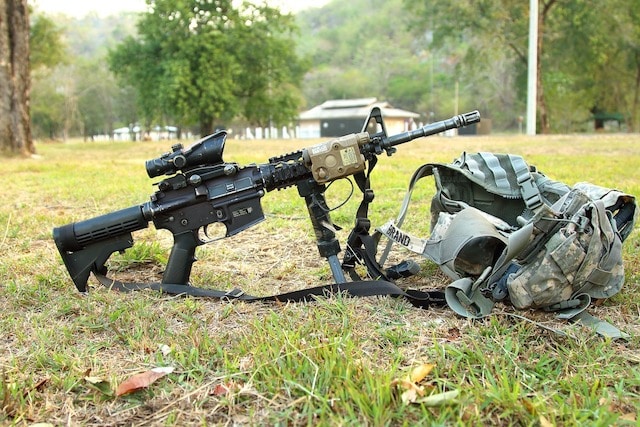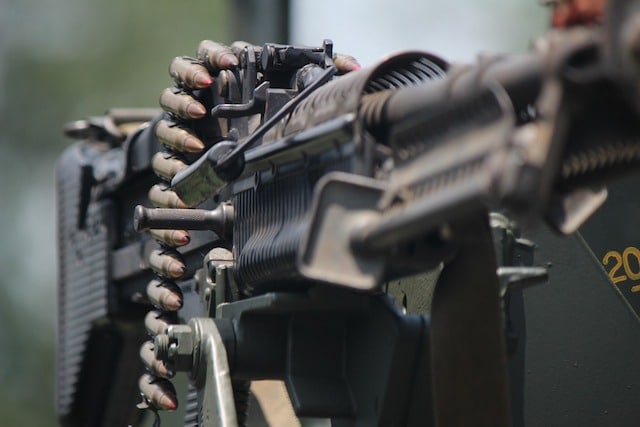War is hell, though most of us have an immensely inaccurate idea of exactly what kind of hell it is. While it was a fairly simple affair for most of our history – two sides with dedicated soldiers facing each other at a specific spot, and returning home with a decisive result either way – that’s not the case anymore.
Modern warfare is instead a full-fledged, global industry of rapidly-advancing technology, private interests, unclear goals, and asymmetric tactics. It has changed so much that when most people imagine a modern battlefield, they’re probably imagining something from the early 20th century.
While some of these misconceptions about modern warfare are shaped up by pop culture and news, others can just be chalked up to most of us having never been near an actual battlefield (and that’s probably for the best).
8. The Myth Of National Forces

When we think of war, we think of nations getting their forces together and matching out to fight each other. While that was true for most of our history, it’s not anymore.
Today, most wars are almost entirely fought by private players, as war is now a much more private and for-profit affair than ever before. The global private military industry is perhaps the largest employer of military personnel in the world. Some of the biggest contractors command forces comparable to major nations. G4S, as an example, has more than three times the number of personnel as the entire British military.
As more and more leaders grow reluctant to put their own citizens on the battlefield, a growing global class of mercenaries is more than happy to fill their shoes. They’re great at rescaling accountability, too, which is why private contractors have been regularly used to carry out major, high-profile missions in a lot of recent wars – especially the invasion of Iraq.
7. Military-Grade

For some reason, it’s assumed that the military is somehow making better things inside their labs than for-profit businesses. We know it as ‘military-grade’; a label quite a few brands use to advertise their products.
As you can guess from the general theme of the list, ‘military grade’ is a myth. While it may have had some basis in reality in the past – as military contracts used to be the primary driver of innovation, not private industry – that’s hardly the case anymore. Because of accelerating innovation in the private sector that started some time in the ’80s, consumer-grade products are as good as, if not better, than anything the military can come up with (unless, of course, it’s classified and only meant for military use).
6. Automatic Fire

We’re not sure if this one is due to war movies or shooter video games, though a lot of us overestimate the role of automatic fire in a real battle. The image of soldiers charging in with rounds and rounds of bullets is definitely badass if you think about it, though in reality, that almost never happens.
In a real battle, soldiers mostly use burst or single fire to shoot and almost never shift to automatic; it’s not rare to hear only a few gunshots during the entirety of a typical modern battle. More importantly, infantrymen are deployed to carry out calculated missions and not mindlessly overwhelm the enemy with automatic fire, as that’s the artillery’s job.
5. The Myth of Victory and Defeat

A major difference between the wars of history and today is that now, it’s much more difficult to tell who won or lost. Victory and defeat are no longer decided by just territorial or strategic goals, as war itself has fundamentally transformed in the past few decades.
Now, wars are fought between mostly non-state actors with unclear allegiances, like foreign guerrilla fighters or private contractors. It’s difficult to maintain the status of victory or defeat if the war has still not ended, which is the case with almost every major war of the past decade. From Iraq to Sudan to Libya, conflict is still actively going on in all of those places, and will likely go on for a long time before any side is decisively declared victorious.
More importantly, global war is a for-profit, growing industry, and it’s impossible to keep that going without consistent conflict in some part of the world. That, combined with the consistently changing definition of war itself, has made military victory and defeat almost completely meaningless.
4. Snipers

When we think about snipers, we think about badass one-man units that operate in the shadows. They’re able to take down anyone they want with one shot without revealing their position, making them an almost invincible foe to locate and take down.
While it’s true that snipers have proven to be massively helpful in the kind of wars like Iraq and Afghanistan, our perception of them mostly comes from over-dramatized Hollywood movies or video games. In reality, being a sniper is more of a science than a combat skill, as it requires consistently solving equations to land the right shot. Moreover, snipers are some of the most vulnerable units in a war, as their work requires them to go out of position and put themselves in danger. In open terrains like a desert or ruined city, it’s surprisingly easy to pinpoint where exactly someone’s shooting at you from, making snipers more prone to being captured than other units.
3. The ‘Short War’ Myth

The notion that wars can be started and won within a short period of time has a long history, and it’s still prevalent enough that we need to talk about it. Some of the longest wars in history and today were supposed to be quick conflicts that you get in and get out of, without exposing your own soldiers to prolonged warfare.
Of course, that notion is entirely a myth, as wars aren’t a compulsory social event that you can just drop in and out of. The misconception persists because time and again – from the First World War to the very-much-ongoing War on Terror – global leaders have used that to convince their populace to enter a war, as no one would willingly want their country to get into a drawn-out, years-long conflict.
Of course, many of those leaders may have genuinely believed that it’s possible to quickly enter, end conflicts and exit, though as almost every major war of the past century or so proves, it hardly ever works that way.
2. The Myth Of Winning From Afar

The perception of war has dramatically changed across the developed world in the last few decades, largely due to the many prolonged and unpopular conflicts of the post-WW2 era, such as the Vietnam War. No longer are people willingly sending their kids to fight for a unified national cause, as drones and cyber warfare replace boots on the ground as the primary and preferred means of waging war.
That’s based on the popular perception that wars are won or lost solely based on how many kills you make. As we discussed above, war in the 21st century doesn’t follow those rules, as it’s often fought by stateless, faceless actors who can’t simply be defeated by brute force. Remote tactics like drones, sanctions, trade wars, etc., aren’t actually meant to achieve any real strategic or tactical goal, but more as a punishment for the enemy that we know we can’t defeat on the field. It’s not just us saying it, either, as generals and military advisors around the world maintain that remote warfare only works in the pre-war stage, or to achieve specific, limited objectives.
1. All Soldiers Shoot To Kill

While it’s not hard to find out why this misconception still exists – just watch any war movie – quite a few of us think that in a typical battle, all soldiers are usually trying their best to kill the other guy. No movie battle has more than half of the soldiers shooting at the ground, in the air or basically anywhere other than the enemy, even if that’s exactly how it is in a real war.
Gone are the days of imperial armies sworn to protect their king; in modern wars – where people are much more likely to resist conscription than earlier – most soldiers simply don’t shoot to kill. Take the Vietnam War, where only 3 out of 10 American soldiers even fired their weapons during combat. The number was even lower during the Second World War, when only 15 to 20 percent of soldiers used their weapons. In fact, desensitizing recruits to kill is a major part of most modern military training routines, as most people inherently do not like killing other people.